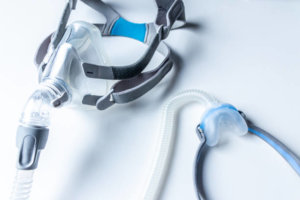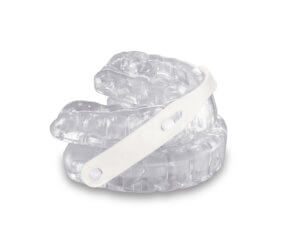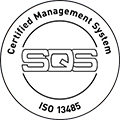Sleep apnoea affects many people, often without them even realising it. Yet this pathology is a source of fatigue and concentration problems, and in severe cases can have a serious impact on health. There are a number of ways of reducing the effects of apnoea, ranging from medical treatments to specific equipment.
Here is a summary of effective solutions for reducing sleep apnoea, including positional therapy and CPAP masks, mandibular orthosesand lingual stimulators. We will also look at possible reimbursements for sleep apnoea products.
The CPAP (Continuous Positive Airway Pressure) machine
The principle is simple: a machine blows pressurised air through a nasal or facial mask, keeping the airways open during sleep. This method is particularly effective in reducing apnoea events, with an immediate positive impact on sleep quality and associated symptoms such as fatigue and irritability. Although the CPAP mask is recognised for its effectiveness, it may require a period of adjustment, as wearing a mask during sleep can be uncomfortable for some people.

Mandibular advancement orthosis
A less invasive alternative to CPAP is themandibular orthosis. This adjustable dental device slightly advances the lower jaw to keep the airway clear. The orthosis is a popular option for mild to moderate apnoea, and is appreciated for its relative comfort and portability. However, its effectiveness depends very much on the patient's morphology, and it requires adaptation and follow-up by a specialist.

Positional therapy
In some cases of sleep apnoea, the obstruction of the airways is mainly present when lying on the back. The positional therapy is a simple but effective solution for people suffering from so-called positional apnoea. This therapy consists of preventing the person from sleeping on their back by using special devices, such as positional cushions or vibrating belts lateral sleep training. Although this treatment is less intrusive than other methods, it is generally recommended for mild to moderate apnoeas. In these cases, positional therapy can significantly reduce the number of apnoeas per hour of sleep.
How do I know if I have positional apnoea?
Positional apnoea is a type of sleep apnoea that occurs mainly in the dorsal position (on the back) and diminishes or disappears in the lateral position (on the side). Here are some signs and methods for checking whether you have positional apnoea:
- Observe nocturnal symptoms Positional apnoea: if you tend to snore loudly or experience pauses in breathing when lying on your back, but these diminish when you sleep on your side, this could be a sign of positional apnoea.
- Use a sleep tracker Some devices, such as connected watches or sleep tracking applications, can detect breathing movements and give you an idea of when your breathing is disturbed. However, the data is not always very accurate.
- Carry out a sleep test A polysomnographic examination carried out in a laboratory or a home sleep test can provide a precise analysis of apnoeas as a function of position. These tests measure several parameters, such as oxygen levels in the blood, frequency of breathing pauses and sleep position.
- Observe daytime symptoms Excessive fatigue, morning headaches, difficulty concentrating or irritability may be signs that your sleep is being disturbed by nocturnal apnoeas, particularly if they occur mainly when you are lying on your back.
Lingual stimulators
A more recent solution that is still little known to the general public is the lingual stimulator such as Inspire Sleep. This device, implanted during minor surgery, stimulates the muscles of the tongue to prevent it from obstructing the airway during sleep. This treatment is generally offered to patients who cannot tolerate CPAP or a mandibular orthosis. Tongue stimulators work by sending mild electrical impulses during sleep to prevent the tongue muscles from collapsing. Although this technology is not yet widely used, it is showing promising results for some apnoea patients.
Possible reimbursements for apnoea treatments
As far as reimbursement is concerned, many treatments for sleep apnoea are covered by health insurance, although this may vary depending on the country and the type of cover.
In France, the Assurance Maladie reimburses the cost of certain medical devices for sleep apnoea, in particular sleep apnoea devices. continuous positive airway pressure (CPAP) and mandibular advancement orthoses. Reimbursement depends on the medical prescription and the agreement of the Assurance Maladie. You should also ask your mutual insurance company if it reimburses part of the cost.
In Switzerland, for example, CPAP devices are reimbursed by basic health insurance, subject to medical diagnosis. Mandibular orthoses may also be covered if prescribed by a specialist. As lingual stimulators are a more recent technology, reimbursements may be rarer and depend on the insurance plan. It is advisable to consult your insurer and healthcare professional about reimbursement options before starting treatment.
Finally, the solutions for reducing sleep apnoea are varied and can be adapted to the needs and preferences of each patient. Whether it's positional therapy, CPAP masks, mandibular orthoses or lingual stimulators, each solution has its own advantages and disadvantages. Technological advances are making it possible to offer ever more effective options, giving patients the chance to regain better-quality sleep. Don't hesitate to consult a sleep specialist to choose the method best suited to your situation and to benefit from any reimbursements.
At Oscimed SA, we are committed to providing innovative and tailored solutions to improve the quality of life of people suffering from sleep apnoea.




